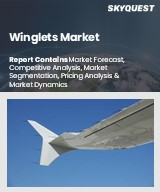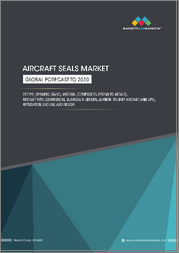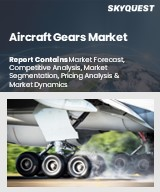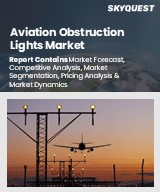
|
시장보고서
상품코드
1693560
중동 및 아프리카의 항공 시장 : 점유율 분석, 산업 동향, 성장 예측(2025-2030년)Middle East and Africa Aviation - Market Share Analysis, Industry Trends & Statistics, Growth Forecasts (2025 - 2030) |
||||||
■ 보고서에 따라 최신 정보로 업데이트하여 보내드립니다. 배송일정은 문의해 주시기 바랍니다.
중동 및 아프리카 항공 시장 규모는 2025년에는 344억 3,000만 달러, 2030년에는 447억 4,000만 달러에 이를 것으로 예측되며, 예측 기간 중(2025-2030년) CAGR은 5.38%를 나타낼 전망입니다.

민간항공은 2023년 70.6%의 주요 금액 점유율을 기록
- 중동 및 아프리카의 GDP는 2021년 대비 20% 증가했고, 유통 이전 수준과 비교하면 17% 증가했기 때문에 중동 및 아프리카의 경제 상황은 안정된 것으로 보입니다.
- 예측기간 중 민간항공부문은 보다 높은 성장률로 확대될 것으로 예측됩니다.
- 상당한 수의 HNWI와 UHNWI가 있기 때문에 중동은 비즈니스 항공 부문에 유리한 산업임이 입증되었습니다. 높은 수준의 호화로움과 쾌적성으로부터, 큰 캐빈과 항속 거리를 가지는 비즈니스 제트는 중동에서 수요가 높습니다.
- 중동 및 아프리카의 군사항공은 튀르키예, 쿠웨이트, 카타르, 바레인에 의한 다양한 항공기 조달계획으로 향후 수년간 성장할 것으로 예측됩니다. 중동에서는 8% 증가했습니다. 이 지역의 나라들은 노후화한 군용기의 근대화와 차세대 항공기의 조달에 상당액의 투자를 실시하고 있기 때문에 고정익 항공기의 성장률이 높아질 가능성이 있습니다.
함대 업그레이드 및 업데이트가 수요를 견인
- 중동은 2022년 4월 현재 세계 항공 여객 수송량의 약 6.5%를 차지하고 있습니다. 아프리카은 2022년 4월 현재 세계 항공 여객 수송량의 약 1.9%를 차지하고 있었습니다.
- 민간 항공기 부문의 납입량은 2021년 대비 2022년에 약 96%의 성장을 나타냈습니다.
- 일반 항공 부문에서 튀르키예는 중동 전체의 비즈니스 제트기 보유 대수의 약 22.3%를 차지하고 비즈니스 제트기의 가동 대수에서 최고 국가이며, 그 다음 사우디아라비아, 아랍에미리트(UAE), 의자 라엘이 각각 약 20%, 2022년 시점의 납입 대수의 12%를 차지하고 있습니다.
- 중동지역의 국방비는 2022년에는 약 1,840억 달러로 2022년 대비 3.2% 이상 감소했습니다.
- 예측 기간 동안, 아랍에미리트(UAE), 사우디아라비아, 카타르, 튀르키예 등 중동 국가들이 항공기 업그레이드를 위해 신형 항공기를 조달할 것으로 예상되므로 이 지역의 항공기 보유량이 증가할 수 있습니다.
중동 및 아프리카 항공 시장 동향
아시아 시장 재개로 걸프 국가의 허브 공항을 통한 트래픽 증가
- 중동 및 아프리카 항공사의 경우 항공 여객 수송량의 회복은 강력했으며 2023년 1분기 전년 동기 대비 성장률은 87.1%와 64.6%였습니다. 중동 및 아프리카에서는 2022년 국제선·국내선 여객수가 2021년 대비 15% 증가했습니다. 중동에서도 지속적인 회복이 보였고, 이란과 쿠웨이트 여행자 수가 각각 26%, 4% 완전 회복에 이르지 않은 것 이외에는 대부분의 나라에서 회복이 보였습니다. 요르단, 카타르, 사우디아라비아, 아랍에미리트(UAE)은 2019년에 비해 강력한 성장을 기록했습니다.
- 2022년 4분기 이집트와 나이지리아는 여객 수송량이 유행 전 수준을 20% 이상 웃돌았습니다. 카타르의 여객수는 같은 기간 전년 대비 40% 가까이 증가했지만, 이는 아랍 국가에서 처음으로 개최된 월드컵에 참가한 여행자들 덕분입니다. 그러나 남아프리카, 이란, 쿠웨이트의 여객 수는 2022년 4분기 시점에서 유행 전 수준을 여전히 10% 이상 밑돌고 있습니다.
- IATA에 의하면 국제선에서 세계 일 이용자가 많은 허브 공항인 두바이 국제공항(DXB)의 2023년 3분기 여객수는 2,290만명을 기록했으며, 분기 기준으로 2019년 이후 최고로 1년간 약 40% 증가했습니다.
- 2022년의 로드 팩터는 중동 및 아프리카계 항공사에서 각각 77%와 80%에 달하고, 2021년의 로드 팩터에 비해 10포인트 이상 상승했습니다. 이러한 사실은 COVID-19 규제 후에도 여행 회복이 기세를 늘리고 있는 것을 나타내고 있습니다. 중동의 많은 주요 국제 노선에서는 이미 COVID-19 이전의 수준을 웃돌고 있습니다.
중동지역의 주요 군사대국은 국방비를 급증시키고 있습니다.
- 중동의 2022년 국방비는 약 1,840억 달러로, 2021년에 비해 3.2% 이상 감소했습니다. 사우디아라비아, 이집트, 카타르, 아랍에미리트(UAE), 알제리 등 국가들은 2017년부터 22년에 걸쳐 국방 지출이 많았던 지역의 주요 국가입니다.
- 사하라 이남의 아프리카 군사비 합계는 2022년에 203억 달러로 2021년 대비 7.3%, 2013년 대비 18% 감소했습니다. 나이지리아와 남아프리카공화국은 두 번째로 큰 지출을 하는 하위 지역으로, 2022년의 군사비 감소를 주도했습니다.
- 사우디아라비아의 군사비의 전년대비(YoY) 성장률은 2022년에는 2021년 대비 16% 증가하여 2018년 이후 전년 대비 증가했습니다. 작년의 군사비는 750억 달러로 추산되었습니다. 이 감소는 사우디아라비아가 예멘에서 군대를 철수하기 시작했다는 비난과 동시에 발생했습니다. 사우디아라비아 정부는 이 의혹을 부인하고, 인원은 재배치되고 있을 뿐이라고 주장했습니다. 2015년부터 사우디아라비아는 전쟁으로 폐허가 된 예멘에 맞서 연합국을 이끌고 있어 전투는 2022년까지 계속 이어졌습니다.
중동 및 아프리카 항공 산업 개요
중동 및 아프리카 항공 시장은 상당히 통합되어 있으며 상위 5개 기업에서 72.57%를 차지하고 있습니다.
기타 혜택
- 엑셀 형식 시장 예측(ME) 시트
- 3개월의 애널리스트 서포트
목차
제1장 주요 요약과 주요 조사 결과
제2장 보고서 제안
제3장 소개
- 조사의 전제조건과 시장 정의
- 조사 범위
- 조사 방법
제4장 주요 산업 동향
- 항공 여객 수송량
- 항공화물 수송량
- 국내총생산
- 수입 여객 킬로(rpk)
- 인플레이션율
- 액티브 플릿 데이터
- 국방 지출
- 개인 부유층(hnwi)
- 규제 프레임워크
- 밸류체인 분석
제5장 시장 세분화
- 항공기 유형
- 민간 항공기
- 서브 항공기 유형별
- 화물기
- 여객기
- 바디 유형별
- 협폭동체 항공기
- 와이드 바디 기계
- 일반 여객기
- 서브 항공기 유형별
- 비즈니스 제트
- 바디 유형별
- 대형 제트기
- 소형 제트기
- 중형 제트기
- 피스톤 고정익기
- 기타
- 군용기
- 서브 항공기 유형별
- 고정익기
- 바디 유형별
- 다용도 항공기
- 훈련용 항공기
- 수송기
- 기타
- 회전익기
- 바디 유형별
- 멀티미션 헬리콥터
- 수송용 헬리콥터
- 기타
- 민간 항공기
- 국가명
- 알제리
- 이집트
- 카타르
- 사우디아라비아
- 남아프리카
- 아랍에미리트(UAE)
- 기타 중동 및 아프리카
제6장 경쟁 구도
- 주요 전략 동향
- 시장 점유율 분석
- 기업 상황
- 기업 프로파일
- Airbus SE
- Dassault Aviation
- Embraer
- General Dynamics Corporation
- Leonardo SpA
- Lockheed Martin Corporation
- Pilatus Aircraft Ltd
- The Boeing Company
- Turkish Aerospace Industries
- United Aircraft Corporation
제7장 CEO에 대한 주요 전략적 질문
제8장 부록
- 세계 개요
- 개요
- Five Forces 분석 프레임워크
- 세계의 밸류체인 분석
- 시장 역학(DROs)
- 정보원과 참고문헌
- 도표 일람
- 주요 인사이트
- 데이터 팩
- 용어집
The Middle East and Africa Aviation Market size is estimated at 34.43 billion USD in 2025, and is expected to reach 44.74 billion USD by 2030, growing at a CAGR of 5.38% during the forecast period (2025-2030).
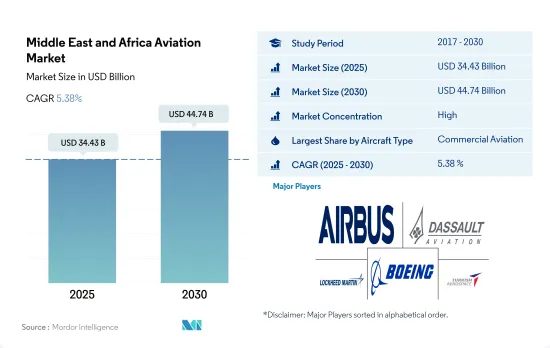
Commercial aviation registered a major value share of 70.6% in 2023
- The economic condition in the Middle East & Africa looks stable as the region's GDP increased by 20% over 2021 and 17% compared to the pre-pandemic levels. As of June 2022, the region's aviation sector supported 11.1 million jobs and USD 276 billion in the GDP.
- During the forecast period, the commercial aviation segment is anticipated to expand with higher growth. The airline companies of the Middle Eastern region witnessed a 116.2% rise in demand in 2022 compared to 2021. With the reopening of international routes and long-haul flights, the demand for passenger aircraft is projected to increase by 66% during the forecast period (2022-2030).
- Due to a significant number of HNWIs and UHNWIs, the Middle East has proven to be a lucrative industry for the business aviation sector. From 2016 to 2021, HNWIs in the Middle East increased by 86%, while those in Africa increased by 19%. Due to their high level of luxury and comfort, business jets with large cabins and extended ranges are in high demand in the Middle East. As of July 2022, large jets accounted for 50% of the Middle Eastern and 36% of the African fleet.
- Military aviation in the Middle East & Africa is expected to grow in the coming years, owing to various aircraft procurement plans by Turkey, Kuwait, Qatar, and Bahrain. Military spending in Africa increased by 6% and by 8% in the Middle East. Fixed-wing aircraft may account for higher growth as countries in the region invest heavily in modernizing their aging military fleets and procuring next-generation aircraft.
Fleet upgradation and replacement programs driving the demand
- The Middle Eastern region had a share of around 6.5% of the global air passenger traffic as of April 2022. The airline companies of the Middle East witnessed a 265% rise in demand in April 2022 compared to April 2021. Similarly, the African region had a share of around 1.9% of the global air passenger traffic as of April 2022. The airline companies of the African region witnessed a 116.2% rise in demand in April 2022 compared to April 2021.
- The deliveries in the commercial aircraft segment witnessed a growth of around 96% in 2022 compared to 2021. The OEMs experienced problems such as a halt in production, supply chain, transportation issues due to lockdowns, and travel restrictions that impacted domestic and international routes. During the forecast period, around 1,080+ commercial aircraft are expected to be delivered to the Middle East & Africa.
- In the general aviation sector, Turkey was the leading country in terms of the active operational fleet of business jets, with around 22.3% of the overall Middle Eastern business jet fleet, followed by Saudi Arabia, the United Arab Emirates, and Israel, with around 20% each and 12% of the deliveries as of 2022. In Africa, South Africa and Nigeria accounted for 25% and 23% of the business jet fleet, respectively.
- Defense expenditures in the Middle Eastern region were around USD 184 billion in 2022, a decline of over 3.2% compared to 2022. In contrast, it was around USD 39.4 billion in Africa in 2022, with a decline of over 5% from 2021.
- During the forecast period, the active fleet may increase in the region, as Middle Eastern countries like the UAE, Saudi Arabia, Qatar, and Turkey are expected to procure newer aircraft for fleet upgradation.
Middle East and Africa Aviation Market Trends
The re-opening of Asian markets is boosting traffic through Gulf hubs
- Air passenger traffic recovery has been strong for the African and Middle Eastern carriers, with year-over-year growth of 87.1% and 64.6% in the first quarter of 2023. In the Middle East & Africa, the number of international and domestic travelers increased by 15% in 2022 compared to 2021. The Middle East has also seen sustained recovery, with most countries having rebounded, except for Iran and Kuwait, where traffic was 26% and 4% short of full recovery, respectively. Jordan, Qatar, Saudi Arabia, and the United Arab Emirates posted strong growth numbers compared to 2019.
- In Q4 2022, Egypt and Nigeria witnessed their passenger traffic perform over 20% above pre-pandemic levels. Qatar's traffic increased nearly 40% Y-o-Y over the same period, boosted by travelers attending the first World Cup hosted in the Arab country. However, passenger volumes in South Africa, Iran, and Kuwait are still more than 10% below their pre-pandemic levels as of Q4 2022.
- According to IATA, The world's busiest hub for international traffic, Dubai International Airport (DXB) recorded 22.9 million passengers in the third quarter of 2023, the highest quarterly traffic since 2019, rising by nearly 40% over a year.
- In 2022, load factors reached 77% and 80% for the Middle Eastern & African airlines, respectively, up more than ten percentage points compared to the 2021 load factors. These facts indicate that the travel recovery continues to gather momentum post the COVID-19 restrictions. Many major international route areas within the Middle East are already exceeding pre-COVID-19 levels. Tourism and the high willingness to travel continue to foster the industry's recovery in the Middle East & Africa.
Major military powers in the region have surged their defense expenditure
- Defense expenditures in the Middle Eastern region were around USD 184 billion in 2022, a decline of over 3.2% compared to 2021. In contrast, it was around USD 39.4 billion in Africa in 2022, with a decline of over 5% from 2021. Countries such as Saudi Arabia, Egypt, Qatar, United Arab Emirates, and Algeria were the major countries in the region with a high defense expenditure during 2017-22. They have active procurement programs for multi-role and utility aircraft in fixed-wing segments.
- Sub-Saharan Africa's combined military expenditure stood at USD 20.3 billion in 2022, down by 7.3% compared to 2021 and 18% compared to 2013. Nigeria and South Africa, the sub-regions two largest spenders, led the decline in military spending in 2022. In 2022, Israel's military spending fell for the first time since 2009. Its total of USD 23.4 billion was 4.2% lower than in 2021.
- The year-on-year (Y-o-Y) growth in Saudi Arabia's military spending was 16% in 2022 compared to 2021, the first Y-o-Y increase since 2018. Saudi Arabia's military expenditure was estimated at USD 75.0 billion last year. The reduction coincided with accusations that Saudi Arabia had started to remove its military personnel from Yemen. However, the Saudi government denied the allegations and insisted that the personnel were just being redeployed. Since 2015, Saudi Arabia has been leading a coalition in a military campaign against the war-torn nation of Yemen, and the fighting continued into 2022. Saudi Arabia had the second-largest military budget in the world, at 7.4% of GDP, after Ukraine in 2022.
Middle East and Africa Aviation Industry Overview
The Middle East and Africa Aviation Market is fairly consolidated, with the top five companies occupying 72.57%. The major players in this market are Airbus SE, Dassault Aviation, Lockheed Martin Corporation, The Boeing Company and Turkish Aerospace Industries (sorted alphabetically).
Additional Benefits:
- The market estimate (ME) sheet in Excel format
- 3 months of analyst support
TABLE OF CONTENTS
1 EXECUTIVE SUMMARY & KEY FINDINGS
2 REPORT OFFERS
3 INTRODUCTION
- 3.1 Study Assumptions & Market Definition
- 3.2 Scope of the Study
- 3.3 Research Methodology
4 KEY INDUSTRY TRENDS
- 4.1 Air Passenger Traffic
- 4.2 Air Transport Freight
- 4.3 Gross Domestic Product
- 4.4 Revenue Passenger Kilometers (rpk)
- 4.5 Inflation Rate
- 4.6 Active Fleet Data
- 4.7 Defense Spending
- 4.8 High-net-worth Individual (hnwi)
- 4.9 Regulatory Framework
- 4.10 Value Chain Analysis
5 MARKET SEGMENTATION (includes market size in Value in USD and Volume, Forecasts up to 2030 and analysis of growth prospects)
- 5.1 Aircraft Type
- 5.1.1 Commercial Aviation
- 5.1.1.1 By Sub Aircraft Type
- 5.1.1.1.1 Freighter Aircraft
- 5.1.1.1.2 Passenger Aircraft
- 5.1.1.1.2.1 By Body Type
- 5.1.1.1.2.1.1 Narrowbody Aircraft
- 5.1.1.1.2.1.2 Widebody Aircraft
- 5.1.2 General Aviation
- 5.1.2.1 By Sub Aircraft Type
- 5.1.2.1.1 Business Jets
- 5.1.2.1.1.1 By Body Type
- 5.1.2.1.1.1.1 Large Jet
- 5.1.2.1.1.1.2 Light Jet
- 5.1.2.1.1.1.3 Mid-Size Jet
- 5.1.2.1.2 Piston Fixed-Wing Aircraft
- 5.1.2.1.3 Others
- 5.1.3 Military Aviation
- 5.1.3.1 By Sub Aircraft Type
- 5.1.3.1.1 Fixed-Wing Aircraft
- 5.1.3.1.1.1 By Body Type
- 5.1.3.1.1.1.1 Multi-Role Aircraft
- 5.1.3.1.1.1.2 Training Aircraft
- 5.1.3.1.1.1.3 Transport Aircraft
- 5.1.3.1.1.1.4 Others
- 5.1.3.1.2 Rotorcraft
- 5.1.3.1.2.1 By Body Type
- 5.1.3.1.2.1.1 Multi-Mission Helicopter
- 5.1.3.1.2.1.2 Transport Helicopter
- 5.1.3.1.2.1.3 Others
- 5.1.1 Commercial Aviation
- 5.2 Country
- 5.2.1 Algeria
- 5.2.2 Egypt
- 5.2.3 Qatar
- 5.2.4 Saudi Arabia
- 5.2.5 South Africa
- 5.2.6 United Arab Emirates
- 5.2.7 Rest of Middle East and Africa
6 COMPETITIVE LANDSCAPE
- 6.1 Key Strategic Moves
- 6.2 Market Share Analysis
- 6.3 Company Landscape
- 6.4 Company Profiles
- 6.4.1 Airbus SE
- 6.4.2 Dassault Aviation
- 6.4.3 Embraer
- 6.4.4 General Dynamics Corporation
- 6.4.5 Leonardo S.p.A
- 6.4.6 Lockheed Martin Corporation
- 6.4.7 Pilatus Aircraft Ltd
- 6.4.8 The Boeing Company
- 6.4.9 Turkish Aerospace Industries
- 6.4.10 United Aircraft Corporation
7 KEY STRATEGIC QUESTIONS FOR AVIATION CEOS
8 APPENDIX
- 8.1 Global Overview
- 8.1.1 Overview
- 8.1.2 Porter's Five Forces Framework
- 8.1.3 Global Value Chain Analysis
- 8.1.4 Market Dynamics (DROs)
- 8.2 Sources & References
- 8.3 List of Tables & Figures
- 8.4 Primary Insights
- 8.5 Data Pack
- 8.6 Glossary of Terms
샘플 요청 목록




